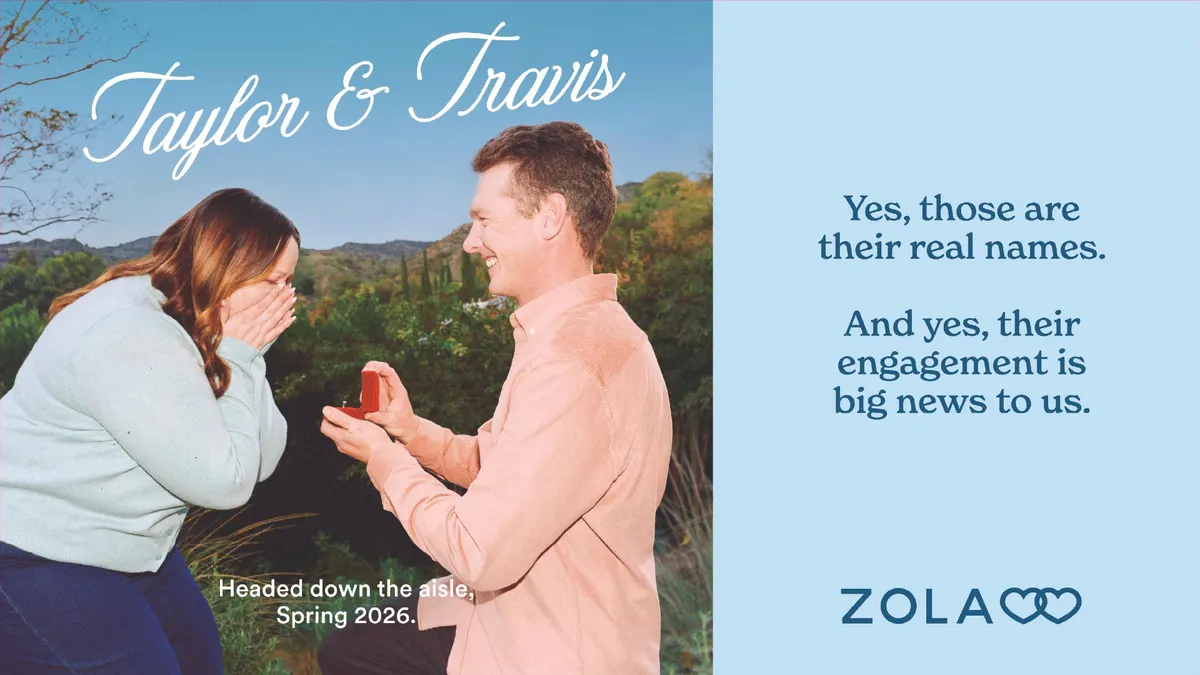For decades, peanut butter brand Jif ran a tagline that helped enshrine it as a household name: "Choosy mothers choose Jif." The memorable phrase, which eventually swapped "mothers" for "moms," sharpened Jif's edge against rivals Skippy and Peter Pan to place it as No. 1 in the category, where it remains to this day. By most metrics, it was an effective positioning for the spread.
Jif's marketing looks markedly different in 2021 than 2001, and in ways that speak to how pockets of the packaged goods sector are dropping a focus on domesticity for strategies more tapped into consumer culture. That pivot has been informed by technological advances, including better targeting and insights, but also a changing shopper base that is potentially averse to being pigeonholed as homemakers.
For many companies, creating cultural relevance outside the home could be an uphill battle. CPGs might need to put in extra legwork to successfully court even choosier young groups like Gen Z, especially as loyalty becomes harder to hold onto amid a boom for private label, direct-to-consumer and e-commerce brands. A recent study by market research consultancy Reach3 Insights found 45% of surveyed U.S. consumers switched their preferred brands across categories during the pandemic, and 85% plan to stick with their new choices. But that same fickleness is emblematic of why CPGs should consider a more culturally led approach as they try to make an impression that carries over to the checkout line or final click.
"Brand loyalty is really something that is, in fast-moving consumer goods, more of an aspiration than a reality," said Matt Kleinschmit, founder and CEO of Reach3. "As a result of that, modern marketers in the CPG world have latched on to this idea of trying to establish emotional connections with consumers.
"If there's an emotional connection, that will often trump functional benefits," he added. "Brands that can execute that in a smart way are winning."
Hitting refresh
An ad campaign Jif rolled out in August stars the rapper Ludacris as he adapts his fast-flowing style to that of modern "mumble rap," whose stars have been criticized by old-school fans. The concept was informed by a social listening insight that some up-and-comers are painted by rap's legacy gatekeepers as sounding like they have peanut butter on the roof of their mouths. In the "Lil Jif Project" spots, which seek to bridge the genre divide, there's nary a reference to anyone's mom, though one of Ludacris' daughters does make a cameo to offer the song a co-sign from the younger generation.
Jif for years was already putting less emphasis on its "Choosy moms" positioning, but made a more radical shift after parent J.M. Smucker tapped Publicis to freshen up the brand's portfolio in 2018. Starting last year, Jif began to seek out ways to intersect more with culture, including through a campaign that played on debates over the pronunciation of the Gif image format, heralding a new era for the peanut butter marketer's identity under the "That Jif'ing Good" platform.
"What CPG has done — and it's an important step — is walk away from thinking all of their ads need to be holding a mirror up to their audience: 'This is you cleaning the counter, this you making a cup of coffee.' That doesn't make you feel anything for the brand," said Erica Roberts, chief creative officer of Publicis New York and an architect of the Jif campaign. "You don't start to create any deeper connection points or memory structures for that matter."
Other CPGs are pursuing similar refreshes. Kraft Heinz's Oscar Mayer label last spring introduced a brand overhaul in the first major work from creative agency of record Johannes Leonardo. The "Keep It Oscar" campaign eschews traditional storytelling in favor of Dadaist absurdity, with videos that depict toddlers shooting lasers from their eyes and bacon taking on a life of its own.
On the media front, the 138-year-old purveyor of hot dogs and lunch meats is experimenting with formats, including GIFs and its first five-second TV ads, that recognize a more attention-strapped consumer economy that's attuned to a constant scroll of social media. Recent extensions speak to a larger eye on Gen Z and millennials as well: Oscar Mayer in August partnered with Lyft to convert its signature Wienermobile into a ride-sharing vehicle, and in September, dropped a capsule collection of "Street Meat" streetwear that was sold through hot dog stands.
The pop-art creative plays come on the tails of sales windfall for Kraft Heinz, which benefited from the pandemic's bump in at-home cooking. Oscar Mayer previously had been something of an albatross for the company, meaning "Keep It Oscar" could serve as a key test of whether the more culture-oriented approach pays off in relation to the bottom line.
But CPGs don't typically foster the same amount of enthusiasm as other categories, like apparel or technology. It's harder for consumers to get worked up about oatmeal or deodorant to the degree they do a new iPhone drop. Still, drawing a clearer connection between a CPG brand and trending discussions — whether they be around a celebrity, major event or piece of pop culture — could become more significant for a population that's constantly plugged in.
"With fast-moving consumer goods, the thought is you use it and dispose of it. They don't necessarily have the same type of cache that some of these other brands maybe would," Kleinschmit said.
"I would actually argue that that's even more of the reason why a lot of these modern marketers that work for these large CPGs are trying to bring that idea of cultural relevance to the forefront," he said. "Without that cultural relevance, they're one of dozens of other products in an increasingly crowded virtual e-commerce shelf."
Redefining roles
Another factor that could motivate CPGs' move toward more culture-centric marketing is the pressure to address a history of propping up normative domestic roles. Images of a housewife in an apron cooking and cleaning were woven into the fabric of U.S. consumer culture with the help of ads devised by largely male agencies and marketing teams of the "Mad Men" era.
"There's almost a sense of responsibility to redefine how we show up and to consciously refuse to perpetuate those stereotypes."

Erica Roberts
Chief creative officer, Publicis New York
Some brands have tried to tackle the touchy subject head-on. Budweiser in 2019 reimagined sexist ads from the '50s and '60s to be more empowering in honor of International Women's Day. While the direct approach isn't common, it might benefit the category to reassess where and how its products are portrayed.
"CPG probably has the most reason to kind of walk away from that narrow targeting to moms because they've been so responsible for perpetuating this antiquated division of labor," Publicis' Roberts said. "There's almost a sense of responsibility to redefine how we show up and to consciously refuse to perpetuate those stereotypes."
Many women today would rather be targeted based on their interests or hobbies rather than as parents, specifically, according to experts. That's especially true of younger groups like Gen Z and millennials that put a premium on social values. Disruptors from the DTC world and other categories have made dents in legacy businesses not only through more digitally savvy sales models, but also a clearer sense of brand purpose than their legacy peers.
"If you talk to a mom, there's this very responsible, functional message. You want to choose something good because you're buying it for your kid," said Jennifer Baldwin, executive vice president and strategic planning director at Publicis. "That as a point of difference can erode over time. That's happening, really, across all packaged goods. There are more entrants coming into the category as private label becomes more appealing."
That's not to say moms aren't part of the picture for CPGs. Women, generally, are still estimated to make between 70-80% of household purchases. A recent Kearney report adds further shades of nuance to the conversation. The consultancy's poll of 1,000 women found 60% valued a "female-focused approach" when being marketed to for household products, but 42% stated that women didn't have gender-specific needs. Nearly a third worried that female-focused products could create or reinforce stereotypes.
At the same time, CPGs must consider another reality: There are simply fewer parents to market to. U.S. Census Bureau data shows that one in six older people are now childless, with that trend expected to continue in the years ahead. Marketers shouldn't pin their hopes on Gen Zers reversing the situation, even as they wield increasing purchasing power.
"If you really look at demographic data, parents are declining. There are fewer households with kids today. Year-over-year, that's going down," Baldwin said. "That meant that after this 50-plus year focus on parents, [Jif] was losing relevance with younger consumers."
Tactical switch-up
Changing demographics create opportunities for CPGs to reach new and even unexpected audiences. Jif, for example, is trying to recognize decision-makers like college students who are buying their own groceries for the first time or fitness enthusiasts who value peanut butter as a protein source. That thinking is reflected in influencer partnerships and larger investments in emerging social media platforms.
"We continue to go back to TikTok because we've found such a diverse audience there and a diverse group of influencers," said Cadence Ely-Mooney, a senior account supervisor at MSL, another Publicis unit that works on the Smucker account. "Not only are we looking at diversification across platforms, but in terms of people we're partnering with ... This kind of expansion has allowed us to be considered more along the lines of a lifestyle brand."
Jif's audience in the 18 to 34 range is 67.25% female, according to an independent analysis Helixa conducted for Marketing Dive, and expresses a 3.68-times affinity toward Ludacris versus the 1.00 national average index. That suggests the "Lil Jif Project" campaign could resonate, even as it's distinctive from the brand's past marketing.
"If you talk to a mom, there's this very responsible, functional message ... That as a point of difference can erode over time."

Jennifer Baldwin
EVP, strategic planning director, Publicis
In trying to thread the needle between ads that connect while not reading as tone-deaf, CPGs have more tools in their kit than before. An explosion of interest for connected TV and streaming during the pandemic — along with the continued movement of media dollars to digital and social as the ad market continues to rebound — is leading to an influx of solutions that open a greater degree of granularity than what linear media can offer. One takeaway is clear: broad, demographic-based targeting is out of vogue.
"It's a larger trend just in general, approaching marketing and messaging to people via interests," Roberts said. "Even the way we do our segmentation work is much more psychographic now and interest-based."
Marketing service providers similarly are trying to meet the cultural moment. Taco Bell, while not a CPG, named Cashmere its first culture agency of record in August to deepen its connection to areas like sports, fashion, gaming and music. That's a tack CPGs could follow as they look to freshen up their image and engage younger consumers who are more skeptical than older cohorts and willing to call out brands that fail to pass the authenticity sniff test.
"Moving forward, not only is it going to be important from a cultural perspective to say what and who to align yourself to, it's going to be equally important for these brands to know what not to say," Kleinschmit said. "For brands and products that are sort of out of alignment … all of a sudden that brand turns into persona non grata.
"There's a whole host of these types of fickle pop culture preferences that brands need to continually be on top of," he added.





















